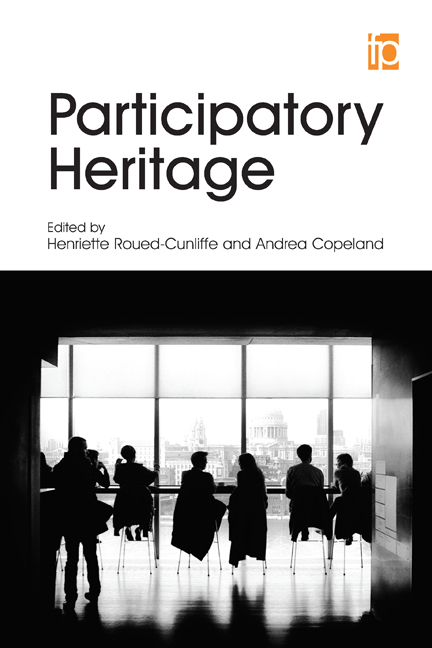Book contents
- Frontmatter
- Contents
- List of figures and tables
- Contributors
- Introduction: what is participatory heritage?
- Part 1 Participants
- Part 2 Challenges
- Part 3 Solutions
- 14 Ethiopian stories in an English landscape
- 15 Having a lovely time: localized crowdsourcing to create a 1930s street view of Bristol from a digitized postcard collection
- 16 Digital archiving in Canadian artist-run centres
- 17 New approaches to the community recording and preservation of burial space
- 18 A case for collaboration: solving practical problems in cultural heritage digitization projects
- 19 Open heritage data and APIs
- Further reading
- Index
17 - New approaches to the community recording and preservation of burial space
from Part 3 - Solutions
Published online by Cambridge University Press: 08 June 2018
- Frontmatter
- Contents
- List of figures and tables
- Contributors
- Introduction: what is participatory heritage?
- Part 1 Participants
- Part 2 Challenges
- Part 3 Solutions
- 14 Ethiopian stories in an English landscape
- 15 Having a lovely time: localized crowdsourcing to create a 1930s street view of Bristol from a digitized postcard collection
- 16 Digital archiving in Canadian artist-run centres
- 17 New approaches to the community recording and preservation of burial space
- 18 A case for collaboration: solving practical problems in cultural heritage digitization projects
- 19 Open heritage data and APIs
- Further reading
- Index
Summary
CRITICAL DISCOURSE SURROUNDING the use of digital technology within archaeology has tended to portray the discipline as a consumer of preexisting technology and has rarely seen itself as an agent of technological development or innovation (Huggett, 2015). Increasingly, however, as barriers to participation in software development have fallen, archaeology has played a small but significant role in the development of digital technology (Wilson and Edwards, 2015; Beale and Reilly, in press). Of equal significance to technological development has been the focus within archaeology upon the development of digital practice in response to the specific social, cultural and political conditions within which archaeological work takes place (Jeffrey et al., 2015; Perry and Beale, 2015).
These developments have been of particular significance within community archaeology where archaeological practice can be a nexus for identity formation and the recasting of the relationship between people and places (Smith, 2006). The shape of practice, and the role of technology within it, can have a powerful influence on the experience of the archaeologist. The meaning, function and perceived value of technology are dictated to a significant degree by the conditions of use and the preconceptions of users. This is complicated still further by the asymmetrical power relationships which have been an endemic feature of the archaeological research community and which have resulted in the privileging of specific ways of working and thinking about archaeological practice (Collins, 1999; Conkey, 2005; Hamilakis, 2007). As we move towards the development and recognition of increasingly diverse research communities it is imperative that we understand technology not only in terms of perceived (abstract) affordances but in terms of their use and their impact within specific social, political and cultural scenarios.
In this chapter we describe the latest developments in the Re-reading the British Memorial project, a University of York-based research project which aims to enable the use of open source and low-cost technologies by community groups involved in the archaeological and historical study of burial space in the United Kingdom. This project responds to the urgent need to re-engage communities in the use and management of burial space. A range of social and environmental factors have created a situation in which burial spaces are at risk as heritage assets and as community resources (Ray et al., 2014; Jones, 2016; Mytum et al., 2015).
- Type
- Chapter
- Information
- Participatory Heritage , pp. 173 - 184Publisher: FacetPrint publication year: 2017
- 1
- Cited by



